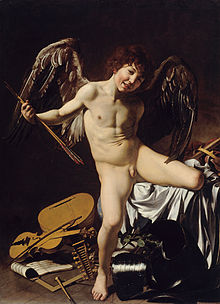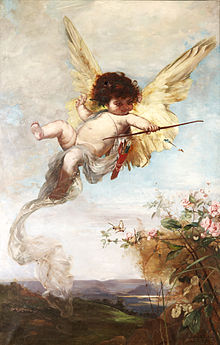Cupid
Cupid, often also called Cupido, is the god and personification of love (more precisely: of falling in love) in Roman mythology and is perceived as an adolescent boy, not without mischievous malice, who strikes the heart with his arrows and thereby awakens love. He cannot be resisted: Omnia vincit Amor ("Amor conquers all", whereby the Latin word "amor" can also be translated directly as "love").
Cupid's Greek analogue is Eros. According to the descent of the Greek Eros from Aphrodite and Ares, Cupid is the son of Venus and Mars. In both Greek and Roman mythology, it is a personification of the abstract concept of "love". According to the literary evidence, Cupid/Cupido is identical with Eros. The Roman personification apparently did not take place independently, but according to the Greek model. From the 5th century BC, the Romans were familiar with the figure of the Greek god of love. Cupid is first attested in the surroundings of Rome as an inscription on a Faliscan stamnos from the 4th century BC. On the vessel he is depicted as Ephebe alongside Ganymede and Jupiter, with all the gods given their names. The oldest literary evidence is found in the fragmentary preserved comedy Gymnasticus by Gnaeus Naevius from the late 3rd century B.C. In stage plays by Plautus, a contemporary of Naevius, we find the oldest evidence of Cupid being used as a god's name alongside Cupid. However, Plautus differentiated, he assumed two love gods, different in their nature: Cupid was responsible for love, Cupid for desire.
Probably the best known mythical tale of Cupid is the tale of Cupid and Psyche embedded by Apuleius in his novel Metamorphoses.
In emblematics, Cupid is also often depicted as blind, which is how William Shakespeare explains it in A Midsummer Night's Dream:
Love sees through the imagination,
Not through the eyes, and therefore The
gold-winged Cupid is painted blind.
Winged without eyes, he indicates
Love's haste in choosing;
And because she easily leaves what she's earned,
So he's pictured as a boy;
As boys often get mystical at play,
So the boy Cupid's recklessness also jokes With
his vows.
Analogous to the Greek erotes, the multiple representations of childlike gods of love, there are cupids to Cupid, who are usually depicted as naked, winged boys. In art they appear, for example, in Watteau's painting Embarkation to Kythera.

Omnia vincit Amor (Cupid conquers all) , Michelangelo Merisi da Caravaggio, 1602

Cupid shooting back , Julius Kronberg, 1885

Embarkation for Kythera , Jean-Antoine Watteau, 1718
Search within the encyclopedia